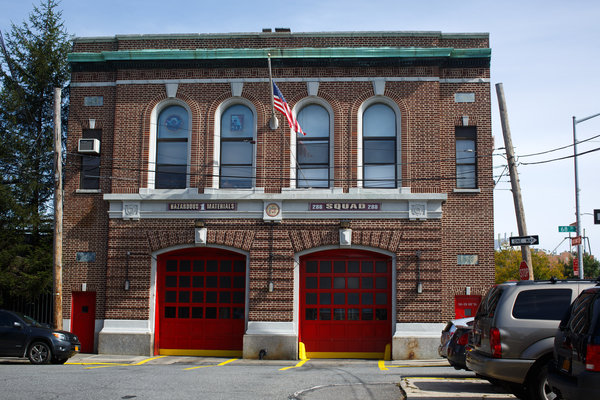By David W. Dunlap The New York Times

The Maspeth firehouse, Hazardous Materials Company 1, Squad 288, had 19 members of its squadron die on September 11. The company is campaigning for landmark designation to help fight off threats of closing. Richard Perry/The New York Times
There is an old red brick, neo-Georgian building in Elmhurst, Queens, that looks like a firehouse from a movie studio lot: two truck bays with roll-down red doors — side by side, for engine and ladder — under four tall windows and an entablature embossed with the city seal.
A memorial near the Squad 288 firehouse lists the names of firefighters from the squad who died on September 11.
There is also an old red brick, neo-Georgian building in Maspeth, Queens, that looks like a firehouse from a movie studio lot: two truck bays with roll-down red doors — side by side, for engine and ladder — under four tall windows and an entablature embossed with the city seal.
Only one is being discussed as a possible New York City landmark.
What’s the difference?
The Maspeth firehouse, Hazardous Materials Company 1, Squad 288, commands a direct view of Lower Manhattan, six miles to the west.
“When those bay doors opened on 9/11, the World Trade Center was right in front of them,” said Lee Ielpi, a retired firefighter whose son, Jonathan Lee Ielpi, was a member of Squad 288.
“They knew exactly where they were going and what they were headed into,” Mr. Ielpi said, referring to the Squad 288 firefighters. “I don’t know what they were thinking, but ahead of them was where they were going to die.”
Jonathan Ielpi and 18 other firefighters and officers from Hazardous Materials Company 1 and Squad 288 perished that day. (Some were assigned to other companies, and are counted with those units in the memorial roll.)
That dreadful distinction, along with the building’s impending centenary, are what prompted Steve Fisher, 62, a retired architect who grew up in and lives in the area, to campaign for landmark designation of the Maspeth firehouse, at 68th Street and Borden Avenue.
The building’s emotional resonance is indisputable, but whether that is enough to make it a landmark remains to be seen.
Mr. Fisher said landmark status would ensure that “the families of those who lost their lives while stationed at this firehouse will always have a place to return to and remember.”
Janice Waters, the widow of Capt. Patrick J. Waters of Hazardous Materials Company 1, recalled the experience of driving up to the firehouse on September 12, 2001. In a letter to the Landmarks Preservation Commission, she wrote:
“The community surrounding the firehouse was surrounding the firehouse — with flowers, posters, flags, food and prayers. It was a comforting sight. For many, many months after, this firehouse was the meeting place not only for the families, but for the community as well.”
Kenneth Rudzewick, the president and chief executive of Maspeth Federal Savings, asked the commission to “take into account the tremendous price the firefighters at this firehouse paid.” The bank’s main office, 56-18 69th Street, is next door.
The Maspeth firehouse was designed by Morgan & Trainer, the architects of at least 10 buildings for the Fire Department. It housed Engine Company 288 and Ladder Company 138 when it opened in 1914.
There is little to recommend it architecturally other than as a competent work of civic design. It is certainly not unique; not with an identical twin at 86-53 Grand Avenue in Elmhurst.
“Although it’s similar to a number of other firehouses that were constructed at that time across the city, it lacks the features, style and other qualities of those that were or have been landmarked,” said Elisabeth de Bourbon, a spokeswoman for the commission.
Those stationed there are conscious of the building’s legacy. But they said they did not dwell on it. “You bond with the people you work with more than you bond with the building,” one firefighter said.
More to the commission’s liking is the monumental Engine Company 268 and Ladder Company 137 firehouse at 259 Beach 116th Street in Rockaway Park, Queens, which was designated in February for its “imposing” design.
Though the commission can consider buildings that have little architectural significance, it has generally been reluctant to do so. Only 11 structures were designated principally for their historical or cultural distinction. The Louis Armstrong House Museum in Corona, Queens, is among them.
Nothing about the exterior of the Maspeth firehouse suggests its especially dolorous role in the World Trade Center attack. There are no bas-relief memorials, as there are at some firehouses whose ranks were devastated on September 11. There isn’t even a small plaque.
The tablet of a free-standing memorial in a nearby plaza declares: “Squad 288 / Hazmat 1 had the single largest loss of firefighters of any F.D.N.Y. firehouse.” But the text does not instruct a visitor that what appears to be a nondescript building 150 feet away is the back of the firehouse itself.
“When speaking of that tragic day 12 years ago, it is often said, ‘We will never forget,'” Mr. Fisher said. If the firehouse is not designated, he said, the city may one day sell the site to a new owner who will replace it.
“How then,” Mr. Fisher said, “can we hope to ‘never forget’?”
A version of this article appears in print on October 10, 2013, on page A26 of the New York edition with the headline: Seeking to Preserve a Plain Brick Firehouse to Remember a 9/11 Sacrifice.

